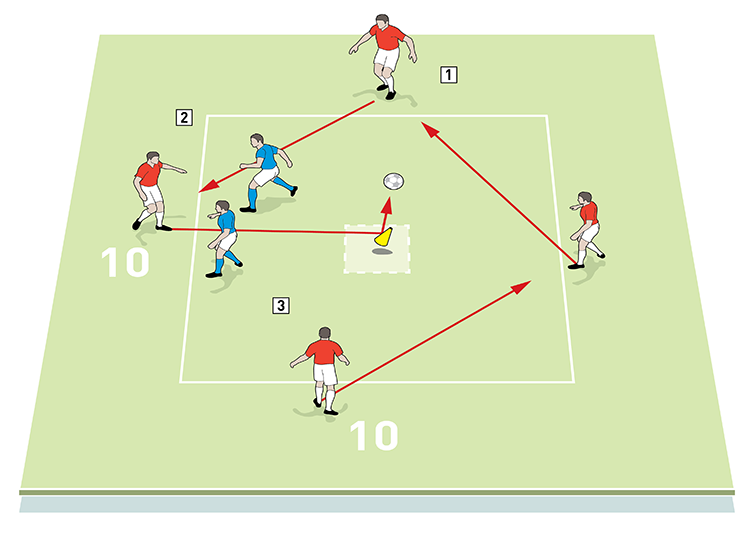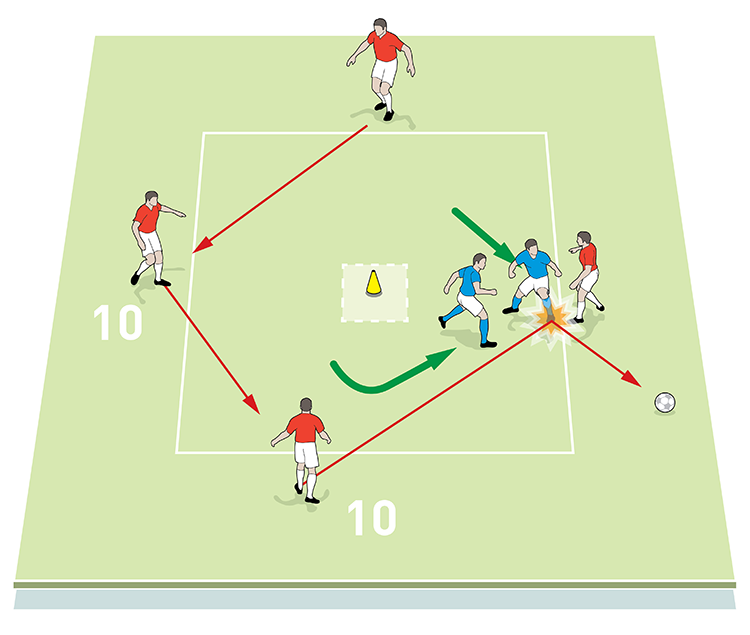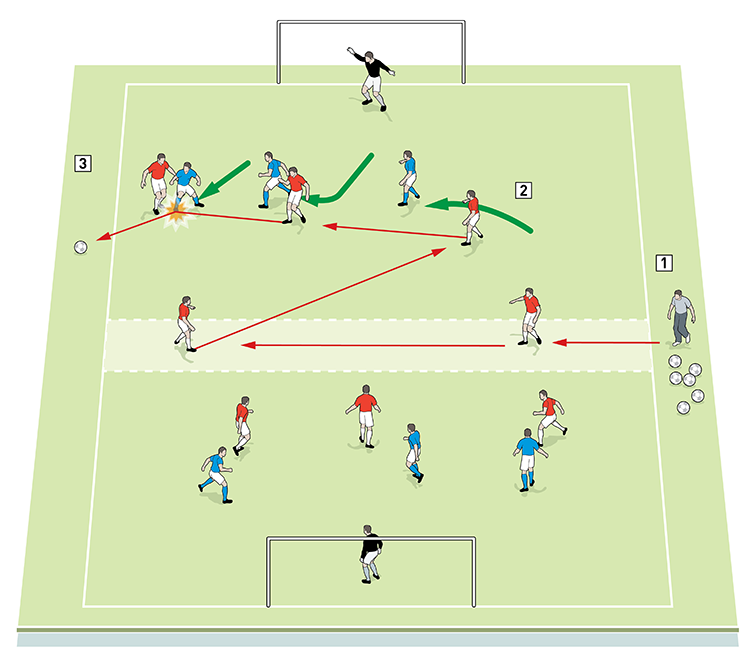




OUR BEST EVER OFFER - SAVE £100/$100
JOIN THE WORLD'S LEADING PROFESSIONAL DEVELOPMENT PROGRAMME
- 12 months membership of Elite Soccer
- Print copy of Elite Player & Coach Development
- Print copy of The Training Ground
You are viewing 1 of your 1 free articles
Defending in and around the box
This session is about defending the 18-yard box when in control and when in states of ‘chaos’. It’s a great practice that improves both individuals and collective units, and instills rare fundamentals of the art of defending the red zone/danger zone (or 18-yard box).
| Area | Use of a full pitch |
| Equipment | Balls, bibs, goals, traffic cones |
| No. of Players | Up to 9v9 plus keepers |
| Session Time | 56mins |
This session is about defending the 18-yard box when in control and when in states of ‘chaos’. It’s a great practice that improves both individuals and collective units, and instills rare fundamentals of the art of defending the red zone/danger zone (or 18-yard box).
The reason I like this session so much is because the main content is geared to pressing and protecting. It holds both physical and technical attributes and helps develop player psychology in terms of the demands and skills required when defending our 18-yard box.
The session is challenging, quick, engaging and therefore incorporates fatigue into the process of making correct decisions and seeking satisfying outcomes, and that in itself is something that will always be replicated on match day, the point of the week we truly regard as our ‘teacher’. With that in mind then, sessions such as this provide the building blocks, and this can begin in pre-season, depending on the current needs of the team.
The session will be performed once a week, with parts 2 and 3 combined designed to represent the length of one half of a game. However, various individual parts of this session may well be repeated on a daily basis, as repetition best produces the right outcomes.
What do I get the players to do?
Part 1: Press and protect (10mins)
For this practice we set up with four 10x10-yard boxes, as shown (1a), with the internal shaded area being 2x2 yards. Attackers must stay outside the square in keeping possession, with the objective being to knock over the central traffic cone.
1a

2. Defenders fail to cover passing/attacking lines
3. A shot hits the cone in the centre and a point is scored
Defenders must press and protect. They are not allowed to go into the shaded area, with their objective being to win the ball as many times as possible whilst preventing the traffic cone from being hit.
We play this with 60-second repetitions, instructing defenders to press aggressively, with a secondary press and support. We are looking for body contact – no bobbing, no pointing – just simple, quick, aggressive pressing and, ultimately, an interception (1b).
1b

Part 2: Main practice (4x4mins with 1min rest)
Now we set up as shown (2a), with 3v3s in each 18-yard box and two centre-midfielders stationed (and who must remain) in the middle strip.
2a

2. A pass is played in to the attacking team
3. Attackers go 3v3 towards the goal, but the defender intercepts
The server begins by feeding the ball in to the centre-midfielders, who can either pass to each other or feed a ball in to either end’s attackers. Attackers then go 3v3 in trying to score in the goal. Defenders must try to stop goals at all costs, by blocking, tagging an opponent, or regaining/retaining the ball by whatever means possible. And within this, we want to see them defending individually, collectively and ‘in chaos’.
After four minutes, attackers rotate so defenders go in against fresh opponents.
How do I progress the practice?
A simple progression is to add in attacking wingers, as shown (2b). In possession, these players can choose to run inside the box so as to create an overload, or simply cross to an attacker in the middle. We can also allow the centre-midfielders the opportunity to shoot.
2b

In total, this practice offers different challenges to a simple defending practice, namely in dealing with crosses and covering the movement and unpredictability of full-backs.
What are the key things to look out for?
In each element we are looking for an aggressive press, plus body contact in the press, or body contact on an opponent in advance of them actually receiving the ball. That final point fits in well with the idea of us expecting our players to look to gain the first contact.
Beyond that, working as a unit through good support and communication is a must. And when clearing, players must be precise and reactive to the next phase.
Typical mistakes include players losing concentration on transitions, while poor positional play is also something we must look out for, especially on regains. It’s also important that players deal with disappointment quickly – when goals are conceded we must see positive reactions.
In striving to find the right answers in a session like this, it doesn’t have to be a full playing out of individual elements. For instance, just a conversation can be enough at times, because in complex, pressurised environments simplicity is often the way forward.
How do I put this into a game situation? (2x15mins)
For this final part we move things into a 9v9, full width in three quarters of a pitch. All our small-sided games and practices are position-specific with players represented in their positions. So, for example, we may use a 4-3-2 in respect of our preparation for a forthcoming opponent, with the intention of improving defensive aspects.
Related Files
Editor's Picks
Attacking transitions
Deep runs in the final third
Using the goalkeeper in build-up play
Intensive boxes drill with goals
Penetrating the final third
Creating and finishing
My philosophy
Pressing initiation
Compact team movement
Coaches' Testimonials

Alan Pardew

Arsène Wenger

Brendan Rodgers

Carlos Carvalhal

José Mourinho

Jürgen Klopp

Pep Guardiola

Roy Hodgson

Sir Alex Ferguson

Steven Gerrard
Coaches' Testimonials

Gerald Kearney, Downtown Las Vegas Soccer Club

Paul Butler, Florida, USA

Rick Shields, Springboro, USA

Tony Green, Pierrefonds Titans, Quebec, Canada
Join the world's leading coaches and managers and discover for yourself one of the best kept secrets in coaching. No other training tool on the planet is written or read by the calibre of names you’ll find in Elite Soccer.
In a recent survey 92% of subscribers said Elite Soccer makes them more confident, 89% said it makes them a more effective coach and 91% said it makes them more inspired.
Get Monthly Inspiration
All the latest techniques and approaches
Since 2010 Elite Soccer has given subscribers exclusive insight into the training ground practices of the world’s best coaches. Published in partnership with the League Managers Association we have unparalleled access to the leading lights in the English leagues, as well as a host of international managers.
Elite Soccer exclusively features sessions written by the coaches themselves. There are no observed sessions and no sessions “in the style of”, just first-hand advice delivered direct to you from the coach.







